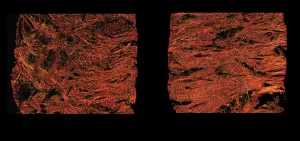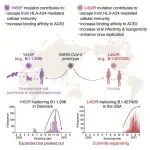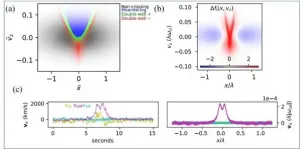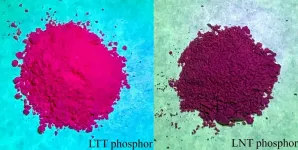Study highlights socioeconomic, racial differences in the financing of medical education
A secondary analysis of AAMC data, led by U of M Medical School students, raises equity concerns as medicine works to improve the diversity of its workforce
2021-07-20
(Press-News.org) MINNEAPOLIS/ST. PAUL (07/20/2021) -- National data analyzed by University of Minnesota Medical School researchers show that nearly 40 percent of all funds used to pay for medical school are expected to come from family or personal sources and scholarships. The prevalence of these sources, however, varies widely by race and socioeconomic status.
Arman Shahriar, Varun Sagi and Lorenzo Gonzalez, all fourth-year students at the University of Minnesota Medical School, are co-lead authors of the study, which was published today in JAMA Network Open.
"Financing a four-year medical education requires upwards of a quarter-million dollars, and this amount has been rising faster than inflation since the 1960s. Prior to this study, little was known about how students pay for medical school, so we set out to shed light on this opaque subject," Shahriar said.
Their research analyzed de-identified data from more than 29,000 medical students nationwide who responded to the 2017 to 2019 Association of American Medical Colleges (AAMC) Matriculating Student Questionnaire. The study found that:
- Nearly 25 percent of all medical students come from the top five percent of household incomes (greater than $270,000 in 2019), and 37% of these high-income students will be paying for medical school primarily using family or personal funds. For comparison, only three to four percent of students from the lowest three income quintiles rely primarily on family or personal funds.
- Family or personal financing was more prevalent among Asian students and white students and was least prevalent among Black students. Shahriar says, "This may be a reflection of the widening racial wealth gap - rooted in structural racism - and may explain AAMC data indicating Black students graduate with the highest debt burden of any racial group."
- Between high- and low-income students, scholarships were distributed much more evenly than family or personal funds. The heavier reliance on loans among low-income students suggests an inadequacy of current scholarship amounts to offset the large deficit in family or personal funds that these low-income students face.
"Knowing that scholarship funds are finite, individual medical schools should work to ensure that scholarships are awarded through holistic review with ample consideration of economic background," Shahriar said. "Additionally, considering the degree to which some students are relying on family wealth, medical schools ought to be ensuring equal access to expensive resources during training, like board preparatory materials. As medicine works toward improving its socioeconomic, racial and ethnic diversity, the last thing we want is for family wealth to be influencing educational quality."
The study team is now looking at socioeconomic diversity among matriculating medical students. Shahriar says that future work on the topic of financing should better examine how financing methods have evolved over time for various subgroups, as well as link matriculant financing plans with debt and other economic outcomes at the time of graduation and beyond.
INFORMATION:
This research was funded by the Minnesota Academy of Family Physicians Foundation and the Friedman-Bowen Scholarship grant from the Minnesota Medical Association Foundation.
Other co-authors include Thomas E. Kottke, MD, MSPH, and Gabriela Vazquez-Benitez, PhD, of HealthPartners Institute. The senior author is Renée Crichlow, MD, of Boston University (previously of the U of M Medical School).
About the University of Minnesota Medical School
The University of Minnesota Medical School is at the forefront of learning and discovery, transforming medical care and educating the next generation of physicians. Our graduates and faculty produce high-impact biomedical research and advance the practice of medicine. We acknowledge that the U of M Medical School, both the Twin Cities campus and Duluth campus, is located on traditional, ancestral and contemporary lands of the Dakota and the Ojibwe, and scores of other Indigenous people, and we affirm our commitment to tribal communities and their sovereignty as we seek to improve and strengthen our relations with tribal nations. For more information about the U of M Medical School, please visit med.umn.edu.
ELSE PRESS RELEASES FROM THIS DATE:
2021-07-20
Despite the best efforts of industry to work towards sustainability, most plastics (or polymers) are still made using non-renewable fossil fuels. However, researchers have now found an economical method for producing biobased acrylate resins. The study, published in the journal Angewandte Chemie, shows how all the synthesis steps, from initial building blocks right up to polymerization, can be carried out in a single reactor (one pot), minimizing environmental impact.
Most varnishes, adhesives and paints are made from acrylate resins, which are polymers of acrylic acid esters and methacrylic acid esters. The raw materials that form these ...
2021-07-20
The sight of felled trees and logging activity can be jarring for nature lovers, but from those sites can sprout young forest growth that's especially attractive to a familiar inhabitant of wooded areas throughout the Northeast - bats.
New findings from researchers at the UConn College of Agriculture, Health, and Natural Resources, published in Forest Ecology and Management, finds that a number of bat species native to the Northeast are highly active in newly created forest spaces, foraging for food at higher rates than is typical of mature forests.
Little is known about ...
2021-07-20
Vaccine hesitancy continues to be a hurdle in the development of widespread immunity within the U.S. population as the COVID-19 pandemic enters its second year.
Researchers at the University of Cincinnati College of Medicine have developed a computerized decision analytic model to compare projected outcomes of three vaccine strategies: a patient opts for a messenger RNA vaccine, a patient decides to get an adenovirus vector vaccine or the patient simply forgoes a vaccine altogether.
Pfizer and Moderna produce mRNA vaccines while Johnson & Johnson manufacture an adenovirus vector vaccine. The decision analytic ...
2021-07-20
Surgical scars treated with a molecule called alphaCT1 showed a long-term improvement in appearance when compared to control scars, according to multicenter, controlled Phase II clinical trials - a finding that could help surgeons improve patient outcomes.
Now, a public-private research team led by Rob Gourdie, professor and director of the Center for Vascular and Heart Research at the Fralin Biomedical Research Institute at VTC, has revealed clues about why and how it improves the appearance of scars.
The study, to be published in the August issue of the Federation ...
2021-07-20
When it was discovered in the 1980s in Argentina, this hadrosaur was diagnosed with a fractured foot. However, a new analysis now shows that this ornithopod commonly known as the duck-billed dinosaur actually had a tumour some 70 million years ago, as well as two painful fractures in the vertebrae of its tail, despite which, it managed to survive for some time.
This dinosaur, called Bonapartesaurus rionegrensis, was discovered in Argentinean Patagonia in the 1980s, and the first analyses of its fossils indicated an ailment of the foot, possibly a fracture, as the Argentinean palaeontologist Jaime Powell pointed out at the time. The study of this animal then came to a standstill until 2016, when Powell invited another team of scientists to resume ...
2021-07-20
The Indian Ocean has been warming much more than other ocean basins over the last 50-60 years. While temperature changes basin-wide can be unequivocally attributed to human-induced climate change, it is difficult to assess whether contemporary heat and freshwater changes in the Indian Ocean since 1980 represent an anthropogenically-forced transformation of the hydrological cycle. What complicates the assessment is factoring in natural variations, regional-scale trends, a short observational record, climate model uncertainties, and the ocean basin's complex circulation.
A ...
2021-07-20
PHILADELPHIA--Alzheimer's disease and related diseases can still only be confirmed in deceased patients' brains via autopsy. Even so, the development of biomarkers can give patients and their families answers during life: Alzheimer's disease can be accurately detected via peptides and proteins in a patient's cerebrospinal fluids (CSF), which can be collected through a lumbar puncture and tested while the patient is alive. In 2018, a new framework suggested combining three Alzheimer's disease biomarkers in CSF - pathologic amyloid plaques (A), tangles (T), and neurodegeneration (N), collectively called ATN. According to recent research from the Perelman School ...
2021-07-20
An international team of researchers led by Kumamoto and Tokyo Universities (Japan) have shown that the L452R mutation of the SARS-CoV-2 spike protein, which is common to two mutant strains (Epsilon and Delta), is involved in cellular immunity evasion via the human leukocyte antigen (HLA) A24, and enhances viral infectivity. HLA-A24 is one of the most prominent HLA-class I alleles, especially in East/Southeast Asian populations, which might make them particularly vulnerable to coronavirus variants with this mutation.
The ongoing novel coronavirus (SARS-CoV-2 or COVID-19) pandemic has, as of June 2021, infected over 150 million and killed over 3.5 million people worldwide. Vaccination drives ...
2021-07-20
A Korean research team has identified the origin of bifurcated current sheets, considered one of the most unsolved mysteries in the Earth's magnetosphere and in magnetized plasma physics.
A POSTECH joint research team led by Professor Gunsu S. Yun of the Department of Physics and Division of Advanced Nuclear Engineering and Dr. Young Dae Yoon from the Pohang Accelerator Laboratory has theoretically established the process of collisionless equilibration of disequilibrated plasma current sheets. In addition, by comparing this with particle simulations and satellite data from NASA, the origin of the bifurcated ...
2021-07-20
Overview:
Professor Hiromi Nakano of Toyohashi University of Technology used a material with a unique periodical structure (smart material: Li-M-Ti-O [M = Nb or Ta]) as a host material to synthesize new Mn4+-activated phosphors that exhibit red light emissions at 685 nm when excited at 493 nm. Because the valence of the Mn ions in the material changes from Mn4+ to Mn3+ according to the sintering temperature, composition, and crystal structure, there is a difference in the photoluminescence intensity of the phosphors. XRD, TEM, and XANES were used to clarify the relationship between the photoluminescence intensity and the sintering temperature, ...
LAST 30 PRESS RELEASES:
[Press-News.org] Study highlights socioeconomic, racial differences in the financing of medical education
A secondary analysis of AAMC data, led by U of M Medical School students, raises equity concerns as medicine works to improve the diversity of its workforce





